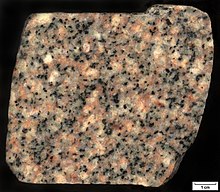|
Quartz monzonite
 Quartz monzonite is an intrusive, felsic, igneous rock that has an approximately equal proportion of orthoclase and plagioclase feldspars. It is typically a light colored phaneritic (coarse-grained) to porphyritic granitic rock. The plagioclase is typically intermediate to sodic in composition, andesine to oligoclase. Quartz is present in significant amounts. Biotite and/or hornblende constitute the dark minerals. Because of its coloring, it is often confused with granite, but whereas granite contains more than 20% quartz, quartz monzonite is only 5–20% quartz. Rock with less than five percent quartz is classified as monzonite. A rock with more alkali feldspar is a syenite whereas one with more plagioclase is a quartz diorite.[1] The fine grained volcanic rock equivalent of quartz monzonite is quartz latite.[1] The term adamellite was originally applied by A. Cathrein in 1890 to orthoclase-bearing tonalite (likely a granodiorite) at Monte Adamello, Italy, in 1890, but later came to refer to quartz monzonite. The term is now deprecated.[2] Quartz monzonite porphyry is often associated with copper mineralization in the porphyry copper ore deposits.[3] Geographic distribution
United StatesIn the White Mountains and western highlands of New Hampshire, the Kinsman Quartz Monzonite is an extensive formation that underlies Kinsman Mountain, parts of Franconia Notch, Mount Cardigan, and Mount Sunapee.[4] Stone Mountain in Georgia is a large quartz monzonite monadnock.[citation needed] Quartz monzonite extracted from a quarry in Little Cottonwood Canyon was used to build several buildings in Salt Lake City, Utah, including the Church of Jesus Christ of Latter-day Saints' Salt Lake Temple, Church Administration Building, and Conference Center, as well as the Utah State Capitol.[citation needed] The large boulders of Joshua Tree National Park in southern California are quartz monzonite.[citation needed] A large pluton in the Atlanta lobe of the Idaho Batholith, near McCall, Idaho, is made of quartz monzonite.[5] The Guilford Quartz Monzonite and Woodstock Quartz Monzonite, probably comagmatic, are located in central Maryland.[citation needed] AustraliaIn Queensland, Castle Hill, Mount Stuart and Mount Louisa around Townsville represent a large quartz monzonite province.[citation needed] References
External links
|
||||||
